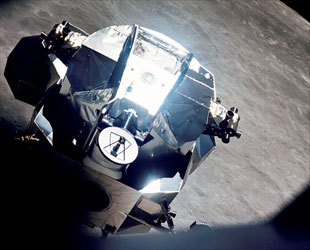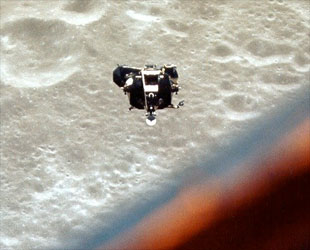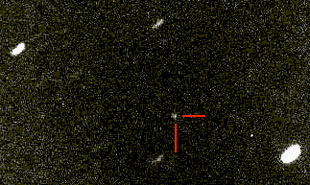September 20, 2011 – A group of amateur astronomers in the United Kingdom, assisted by students and NASA, have set their sights — and their robotically-controlled telescopes — on locating a long lost dog: the U.S. space agency's lunar module "Snoopy."
Launched in May 1969 on the Apollo 10 mission, a dress rehearsal for the first manned lunar landing two months later, Snoopy and its companion Apollo command module "Charlie Brown" were named after "Peanuts" artist Charles Schulz's comic strip beagle and his boy owner. The Apollo 10 crew, Thomas Stafford, Gene Cernan and John Young, chose the cartoon characters as their mission's call signs and unofficial mascots.
Charlie Brown, the Apollo 10 spacecraft, orbited the moon and returned to Earth, splashing down with the astronauts to complete its mission. Snoopy however, would not come home.

"Snoopy," as seen from "Charlie Brown," on Apollo 10. (NASA) |
When its test flight was over, Snoopy was divided into its two sections. The descent stage, which on later missions would remain on the lunar surface, was allowed to crash into the moon. The ascent stage, which included the crew cockpit, was jettisoned such that it entered orbit around the sun.
All of the other Apollo lunar modules' ascent stages were purposely destroyed, either by burning up in the Earth's atmosphere or crashing back onto the moon. That makes Snoopy the only U.S. once-manned spacecraft still in outer space. Forty-two years later, it is still out there — somewhere — waiting to be found.
Faulkes Telescope Project hopes to do just that. Based at the University of Glamorgan in Wales, the group provides free access to robotically-controlled telescopes to engage teachers and students in research-based science.
Snoopy's student search party
"To say it's like finding a needle in a haystack is doing a disservice to the haystacks," Paul Roche, director of the Faulkes Telescope Project, said in a statement. "Whilst there are records of the last known movements and orbital information for Snoopy, this is going back over 40 years. The module has been affected by the gravity of the Sun, Earth and moon for all that time, then you have all sorts of other factors that mean we need to search a very big chunk of sky for this thing."

"Snoopy" never came home. It was jettisoned into a heliocentric orbit and is out there — somewhere — in space today. (NASA) |
To ease the search, Roche and his team members are hoping to enlist the help of UK schools. Students will be challenged to scan the data collected by the telescopes, including the Remanzacco Observatory in Italy and the Jamesburg Earth Station in Cachagua Valley, Calif., the latter a radio telescope that was used in 1969 to relay the TV signals broadcast by Apollo 11 from the moon.
"To paraphrase President Kennedy, we are trying these things 'not because they are easy but because they are hard' — this will be a real test for the hardware and the students involved," Roche said.
The project, which has received consultation from NASA's Jet Propulsion Lab and from former flight controllers who staffed Mission Control, will be attempting to post regular coordinate data that teams will examine on a daily basis.
"There will be a huge search field to examine, so this is not something which will happen overnight. It could take weeks, months, years – or we may possibly never find it," Sarah Roberts, Faulkes education director said. "But we're going to try, and as a bonus, the areas we'll be searching will hopefully turn up new asteroids, and maybe even some comets, so there will be useful results whether we find Snoopy or not,"
From asteroids to ascent stages
Comprehensive wide field sky surveys that were looking for near Earth objects — asteroids that come within about 3 million miles of Earth — have previously failed to find Snoopy. The team however, has been encouraged by their recent success finding many small, faint asteroids.
"Whilst there is every chance we won't find it, it's like the lottery – unless you play, you don't win" said Nick Howes, an astronomer and equipment consultant for Astronomy Now magazine.
The challenge of finding Snoopy was just what Howes, a long time fan of the Apollo missions and a member of the Faulkes team, was seeking. "After the fantastic media coverage and work experience that student Hannah Blyth gained in helping us find over 25 new asteroids, we thought this would be an exciting way to engage schools" he said.
Blyth, 18, made headlines late last month after one of the asteroids she discovered using a Faulkes telescope was proposed to be named for her ("Hannahblyhe").
Howes is hoping to ride that success by crowd-sourcing the search for Snoopy, just as another computer-assisted astronomical search first did more than a decade ago.
"We are looking at this like SETI@Home, the search for radio signals from ET," he said. "The chances of finding anything in that are tiny, but millions of people tried."
"With our Snoopy project, we hope to involve hundreds of schools users, plus the aside of most likely uncovering dozens of new asteroids and maybe some comets in our search areas means we'll be doing great science at the same time," Howes said.
Snoopy's space friends
Although Apollo 10's Snoopy is the primary focus of their search, the Faulkes team hopes the search will find other spent rocket stages along the way.
"We know from the [discovery] of the Apollo S-IVB stage in 2002, which initially was thought to be an asteroid, that they are out there, and are recoverable," Howes said. "So whilst daunting, it's not completely impossible."�
The S-IVB was the third stage of the Saturn V booster that launched Apollo to the moon. Nine years ago, the spent rocket segment from the second moon landing was found floating through space. It was determined not to be an asteroid by measuring the light it reflected. Its spectral properties were consistent with the titanium oxide paint that was used to cover the Saturn V.

Apollo 12 S-IVB stage as seen in 2003. (Sormano Observatory) |
The detection of that Apollo 12 stage offered the Faulkes team an idea of what they may see if they find Snoopy.
"After looking at records in the NASA archives, which give the last known speed and direction of the module, the team knows it will be moving very quickly," the project said in a release. "So even if [we] do find it, initially it will just be a moving blur on the sky. But [we] are encouraged by the re-discovery of the Apollo 12 third stage rocket."
In addition to working with Howes, the Faulkes Telescope Project is also partnering with Mike Loucks, who worked to reconstruct the trajectory of the Apollo 12 spent stage using Analytical Graphics' Astrogator software designed to model spacecraft and satellite orbits. He also modeled the path followed by the Apollo 13 mission.
"Using the techniques from both of those cases, along with some advanced trajectory tools we use to fly real lunar missions, hopefully we can narrow down the search areas to something manageable and give the team a fighting chance of finding Snoopy," Loucks said.
